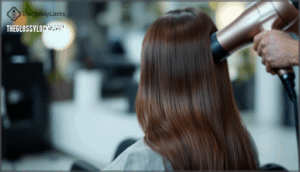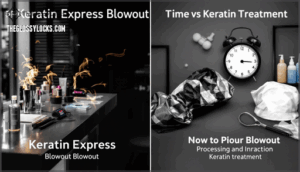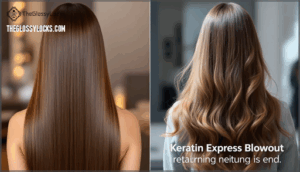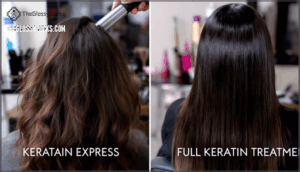This site is supported by our readers. We may earn a commission, at no cost to you, if you purchase through links.
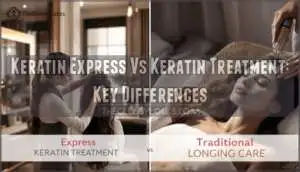 Your hair’s texture changes dramatically depending on which treatment you choose, and the gap between keratin express and traditional keratin treatments runs deeper than processing time alone. A keratin express blowout wraps up in under an hour with lightweight formulations, while a traditional keratin treatment penetrates the hair shaft over several hours, delivering results that last much longer.
Your hair’s texture changes dramatically depending on which treatment you choose, and the gap between keratin express and traditional keratin treatments runs deeper than processing time alone. A keratin express blowout wraps up in under an hour with lightweight formulations, while a traditional keratin treatment penetrates the hair shaft over several hours, delivering results that last much longer.
The difference isn’t just about convenience—it’s about how intensely the treatment works and what your hair actually needs. Understanding what separates these two approaches helps you pick the one that matches your lifestyle, hair goals, and the kind of commitment you’re willing to make.
Table Of Contents
- Key Takeaways
- Keratin Protein and Hair Health
- What is a Keratin Treatment?
- What is Keratin Express Blowout?
- Keratin Express Vs Keratin Treatment
- Benefits and Drawbacks of Each Treatment
- Choosing The Right Treatment for You
- Recommended Products for Aftercare
- Frequently Asked Questions (FAQs)
- What is the difference between keratin treatment and keratin express?
- How long does a keratin express last?
- What is the process of keratin express?
- What type of keratin treatment is best?
- Can pregnant women get keratin treatments safely?
- How long should hair be before treatment?
- Will keratin treatment change my natural curl pattern?
- Can I do keratin treatment on damaged hair?
- What happens if I swim after treatment?
- Can keratin treatments fix severely damaged hair?
- Conclusion
Key Takeaways
- Traditional keratin treatments penetrate deep into the hair shaft over 2-4 hours using 70-80% keratin concentration with formaldehyde-based bonding agents, delivering 3-6 months of up to 95% frizz reduction, while keratin express blowouts use lighter 30-40% formulations with safer glyoxylic acid that wrap up in 60-90 minutes but only last 4-6 weeks.
- The cost-per-week value strongly favors traditional treatments at $1.50-$2.00 weekly versus $3.00-$3.75 for express versions, making the longer-lasting option more economical despite higher upfront costs of $150-$600 compared to express pricing of $100-$300.
- Formaldehyde exposure remains a significant health concern with traditional treatments, as studies found 6 out of 7 keratin brands contained up to 1.4% formaldehyde—seven times the safe limit—with salon air concentrations reaching 3.47 ppm during application, triggering respiratory irritation, scalp reactions, and documented cancer risks.
- Your hair type and lifestyle determine the right choice: thick, coarse, frizzy hair needing dramatic transformation benefits from full treatments offering 80% frizz control for months, while fine-to-medium hair seeking temporary smoothing without heavy commitment suits express blowouts that preserve natural texture.
Keratin Protein and Hair Health
Before you understand how keratin treatments work, it’s helpful to know what keratin actually does in your hair.
This protein isn’t just one thing—it comes in different types, each playing a specific role in your hair’s structure and health.
Let’s break down the science behind keratin and why it matters for your hair.
Types and Functions of Keratin
Keratin protein is classified into two major groups that work together to support your hair’s integrity. Type I keratins are smaller, acidic molecules weighing 40–56.5 kDa, while Type II keratins are larger, neutral proteins ranging from 52–67 kDa.
These keratin types pair up to form intermediate filaments about 10nm wide, creating a rope-like molecular structure strengthened by disulfide bonds between cysteine residues. This structure gives hair keratin its striking tensile strength of approximately 200MPa, rivaling aluminum in durability while remaining flexible enough to withstand daily styling.
Keratin proteins form rope-like structures with tensile strength rivaling aluminum, yet remain flexible enough for daily styling
Birds, however, also utilize a unique form of keratin known as beta-keratin.
Role of Keratin in Hair Structure
Your hair’s strength comes from its internal architecture, where the fiber cortex houses 50–60% alpha-keratins and 20–30% gamma-keratins—together making up 70–95% of each strand’s total mass.
These hair proteins assemble into 10-nanometer filaments through a process where acidic and basic monomers form heterodimers, aggregate into tetramers, and polymerize into the molecular structure that defines your hair’s resilience.
Disulfide linkages between cysteine residues lock this keratin network together, creating the mechanical strength that lets hair strands withstand tension while remaining flexible enough for everyday styling and movement. Raman spectroscopy can be used to analyze these structures.
Benefits of Keratin for Hair
Understanding keratin’s architecture leads directly to recognizing its powerful effects on your hair’s appearance and health. Keratin supplementation delivers a 43.1% reduction in hair loss and shows 17.61% improvement in cortex integrity—real numbers that translate to reduced breakage and stronger strands.
You’ll notice enhanced smoothness as keratin smooths cuticle cells for better light reflection, with 92% of users reporting immediate shine. Styling efficiency jumps dramatically, with drying time cut by 50% and easier combing reported by 87% of recipients.
Temporary thickening occurs as keratin coats individual strands, creating fuller-looking hair in 65% of clients, while follicle health improves through better anchoring and reduced shedding.
What is a Keratin Treatment?
A keratin treatment is a salon process that uses protein-based formulas to smooth frizzy hair and create a sleeker look. The treatment involves several careful steps, from preparing your hair to sealing in the smoothing solution with heat.
Before you book an appointment, it’s important to understand what happens during the process, what results you can expect, and whether there are any safety concerns you should know about.
Process and Application Steps
If you’ve ever wondered what actually happens during a salon service, you’re not alone—the keratin treatment process involves several precise steps. Hair cleansing begins with a clarifying shampoo applied twice to remove buildup, followed by sectioning hair into 4–6 parts.
Solution application starts ¼ inch from your scalp, processed for 15–30 minutes depending on whether you’re getting a Keratin Treatment or Keratin Express Blowout. Heat activation follows through blow-drying and flat ironing at 380–450°F. Processing duration varies greatly between treatments.
Frizz Reduction Vs. Hair Straightening
When you’re weighing your options, it’s worth knowing that traditional keratin treatments report frizz reduction rates as high as 95% on coarse hair, while Keratin Express Blowouts achieve around 85% frizz control.
Straightening longevity differs dramatically—full keratin treatments last 3 to 6 months and cut styling time from 25 minutes down to just 8, whereas Express variants maintain hair smoothing for 4 to 6 weeks with moderate time savings.
Your desired outcome determines the best fit for hair structure improvement.
Potential Health Risks and Formaldehyde
Before you book that appointment, you should know that formaldehyde exposure during keratin treatments carries documented health risks that affect both clients and stylists.
- Immediate symptoms include eye irritation, headaches, dizziness, and respiratory distress at exposure levels as low as 0.1 ppm
- Cancer risks are real—the FDA and American Cancer Society recognize formaldehyde as a known carcinogen linked to uterine, nasopharyngeal cancers, and leukemia
- Allergic reactions like scalp eczema, swelling, and dermatitis appear in 81% of reported cases, often after just two treatments
Studies found 6 out of 7 keratin brands contained up to 1.4% formaldehyde—seven times the safe limit—with salon air concentrations exceeding OSHA’s short-term exposure limit during blow-drying and flat-ironing, creating chemical exposure risks for everyone in the room.
What is Keratin Express Blowout?
If you’re short on time but still want smoother, shinier hair, Keratin Express Blowout might be exactly what you need. This treatment offers a faster alternative to traditional keratin services, delivering quick results without the lengthy commitment.
Let’s break down how it compares to regular treatments, what you can expect during application, and which hair types benefit most.
Express Vs. Traditional Keratin Treatments
Think of the express version as keratin treatment’s faster sibling—same family, different commitment level. Traditional keratin treatments require 2–4 hours of salon time and penetrate deep into your hair shaft using intense heat, while keratin express blowouts wrap up in 60–90 minutes by smoothing primarily the outer layer.
You’ll also notice a difference in formaldehyde content: traditional hair straightening treatments often include formaldehyde or formaldehyde-releasing agents for that long-lasting effect, whereas many express formulas use gentler ingredients with minimal exposure.
Application Time and Results
When you’re looking at application duration, the difference is night and day. Standard Keratin Treatments lock you in for 2–4 hours, while Keratin Express Blowout wraps up in just 60–90 minutes, making it perfect for tight schedules. The longevity comparison tells the real story: traditional treatments deliver long-lasting results for 3–5 months, whereas express options provide a temporary solution lasting 4–6 weeks.
- Application duration: Express treatments finish in 60–90 minutes versus 2–4 hours for full treatments
- Immediate qualities: Both cut styling time in half and boost shine right away
- Longevity comparison: Standard lasts 3–5 months; express fades after 4–6 weeks
- Scheduling needs: Express fits into a lunch break; full treatments require half-day appointments
- Client suitability: Choose express for quick refreshes or events, standard for dramatic smoothing
Suitability for Different Hair Types
Your hair texture determines which option delivers real results. Curly, frizzy hair responds exceptionally well to Keratin Treatment—80–90% of clients see smoother, more manageable curls lasting 3–5 months. Fine hair thrives with Keratin Express Blowout, as over 60% notice improved conditioning and shine for 4–8 weeks without weighing strands down.
Color-treated hair needs caution: wait two weeks after dyeing to prevent up to 10% fading, though 80% still enjoy enhanced shine post-treatment. Textured hair benefits most from full keratin services, with 85% experiencing substantial hair smoothing. Sensitive scalps require patch testing before any keratin-based hair smoothing service.
| Hair Type | Best Treatment Choice |
|---|---|
| Curly hair | Keratin Treatment (3–5 months) |
| Fine hair | Keratin Express Blowout (4–8 weeks) |
| Color-treated hair | Either (wait 2 weeks post-color) |
| Textured hair | Keratin Treatment (deeper penetration) |
| Sensitive scalps | Patch test required for both |
Keratin Express Vs Keratin Treatment
Now that you know what each treatment offers, let’s break down how they actually compare. The differences go beyond just time in the salon chair—they affect your hair’s look, your wallet, and how long you’ll enjoy the results.
Here’s what sets them apart.
Key Differences in Process and Ingredients
You’ll notice these treatments differ markedly in formula composition and application time. Traditional keratin treatments pack 70–80% hydrolyzed keratin proteins with formaldehyde or methylene glycol, requiring 2–4 hours plus a 72-hour waiting period before washing. Keratin Express Blowout uses lighter formulations with only 30–40% keratin concentration and safer glyoxylic acid derivatives, finishing in 45–90 minutes with same-day washing allowed.
The chemical reactions also vary greatly—formaldehyde-based products create permanent methylene bridges for hair straightening through covalent cross-linking at 400–450°F, while express systems rely on ionic bonding at lower temperatures (350–375°F) for hair smoothing without structural alteration. This explains why formaldehyde levels in traditional treatments can exceed 0.75 ppm, triggering safety concerns, whereas express options reduce volatile emissions by 60%.
| Factor | Keratin Treatment | Keratin Express Blowout |
|---|---|---|
| Keratin Concentration | 70–80% hydrolyzed proteins | 30–40% lighter formulation |
| Processing Time | 2–4 hours + 72-hour wait | 45–90 minutes, immediate wash |
| Heat Application | 400–450°F flat ironing | 350–375°F gentler sealing |
| Primary Bonding Agent | Formaldehyde/methylene glycol | Glyoxylic acid or cysteine |
| Ingredient Effects | Permanent structural change | Temporary surface coating |
Longevity of Results and Maintenance
Beyond understanding what goes into each treatment, you’ll want to know how long those results actually stick around. Full keratin treatments maintain long-lasting results for 3–6 months when you follow proper aftercare, while Keratin Express Blowout offers a temporary solution lasting 4–6 weeks.
Your washing frequency plays a huge role—exceeding 2–3 washes weekly can cut treatment lifespan in half, especially if you’re using products with sulfate effects that strip keratin away. Coarse hair texture holds treatments 20–30% longer than fine strands, and consistent heat protection practices can add 4–6 weeks to your hair appearance.
| Factor | Full Keratin Treatment | Keratin Express Blowout |
|---|---|---|
| Duration | 3–6 months with care | 4–6 weeks typical wear |
| Retouch Frequency | Every 4–6 months | Every 6–8 weeks needed |
| Wash-Wait Period | 72 hours post-treatment | 8–24 hours only |
| Maintenance Level | Lower frequency upkeep | Higher touch-up demands |
Cost Comparison and Value
Understanding what you’ll pay upfront versus long-term changes how you view treatment affordability. Full keratin treatments cost $150–$600 at your salon appointment, while Keratin Express Blowout runs $100–$300, making the express option cheaper initially but potentially more expensive over time.
Your hair stylist can help you calculate cost efficiency: traditional treatments deliver $1.50–$2.00 per week of smoothing compared to $3.00–$3.75 for express versions, meaning you’re spending less per result with the longer-lasting option. Maintenance expenses also add up—sulfate-free products run $30–$80, and frequent touch-ups can push annual costs 20–30% higher with express treatments.
| Treatment Type | Upfront Cost | Monthly Value |
|---|---|---|
| Full Keratin Treatment | $150–$600 | $50–$100 over 3–6 months |
| Keratin Express Blowout | $100–$300 | $50–$75 over 4–8 weeks |
Long-term savings favor traditional hair treatments when you’re seeking value perception that lasts, though express works if you’re testing results before committing.
Benefits and Drawbacks of Each Treatment
Both treatments promise smoother, shinier hair, but they come with different trade-offs you’ll want to understand before booking your appointment.
The full keratin treatment delivers dramatic, long-lasting results but requires more time and investment, while Keratin Express offers a quicker fix with shorter-lived benefits.
Here’s what you need to know about the upsides and potential downsides of each option.
Smoothing and Shine Effects
When you compare frizz reduction, traditional keratin treatments deliver up to 95% smoothing and boost shine by over 60%, while Keratin Express Blowout offers more moderate results—around 40% increased shine and lighter frizz control.
Both options work through protein bonding and cuticle smoothing, filling hair porosity with hydrolyzed keratin to create that glossy finish.
Shine duration differs too: classic treatments last for 1 to 3 months, express blowouts for 3 to 5 weeks.
Impact on Hair Texture and Manageability
Traditional Keratin Treatment restructures your hair through disulfide bond reformation, flattening curl patterns for 3 to 5 months and cutting styling time by half. You’ll see lasting hair smoothness and strong frizz resistance.
Keratin Express Blowout offers gentler texture alteration, preserving most curl retention while improving manageability for 4 to 6 weeks. Express works well for manageable hair needing moderate frizz control, whereas full treatments deliver dramatic hair texture transformation for thick, unruly types requiring long-lasting solutions.
Risks, Side Effects, and Safety
Formaldehyde exposure remains the primary health concern with traditional keratin treatments, triggering respiratory irritation and dermatological reactions in both clients and stylists. OSHA testing found concentrations reaching 3.47 ppm during blow-drying—well above the 2 ppm safety limit—while studies link repeated exposure to headaches, eye burning, and asthma-like symptoms.
Key safety considerations include:
- Formaldehyde health risks: Products containing 0.96–1.4% formaldehyde (above the 0.2% limit) can cause scalp rashes, blisters, and eczema-like inflammation.
- Mislabeling practices: Up to 40% of "formaldehyde-free" products release measurable formaldehyde when heated during flat-ironing.
- Occupational hazards: Stylists performing multiple daily treatments face cumulative exposure levels 10–15 times higher than single clients.
- Alternative smoothing options: Glyoxylic acid-based formulas offer lower toxicity profiles with minimal scalp irritation.
You’ll reduce risks considerably by choosing salons with proper ventilation systems, which cut airborne formaldehyde by 82%, and asking specifically about formaldehyde-free alternatives before booking your appointment.
Choosing The Right Treatment for You
Picking the right keratin service comes down to understanding what works for your specific situation. Your hair type, budget, schedule, and daily routine all play a role in determining whether a full treatment or express blowout makes sense.
Let’s walk through the key factors that’ll help you make the best choice.
Hair Type and Desired Outcome
Your hair type and desired outcome determine which treatment works best for you. If you have thick, coarse, or frizzy hair and want a smooth finish that lasts three to five months, a full keratin treatment delivers up to 80% frizz control and markedly reduces your curl pattern.
For fine to medium hair needing lighter frizz control while keeping natural texture, Keratin Express suits you better, lasting four to eight weeks.
Hair porosity also matters—high-porosity strands absorb more treatment solution, enhancing smoothness longevity and overall hair health through targeted hair smoothing treatments.
Budget and Time Commitment
When budget planning, you’ll notice Keratin Express Blowout costs $85 to $200, while a full Keratin Treatment runs $200 to $600—sometimes reaching $800 in upscale salons.
Time efficiency also differs: express takes 35 to 90 minutes versus 2 to 4 hours for traditional treatments.
Though at-home keratin treatments cost $20 to $100, they lack the long-lasting results of professional salon scheduling, making treatment pricing an essential factor in your hair treatment costs decision.
Lifestyle and Maintenance Needs
Your lifestyle determines which treatment keeps up with you. If you’re perpetually busy, Keratin Express delivers frizz control and easier styling in 35–90 minutes, lasting 4–6 weeks, making it perfect for quick touch-ups.
For longer-lasting smoothness requiring less frequent salon visits, traditional keratin treatments work better—lasting 3–5 months with proper daily hair care. Both simplify your routine by reducing styling time and product needs.
However, traditional treatments demand stricter keratin aftercare: limit washing to 2–3 times weekly, use sulfate-free products, avoid chlorine and heat styling, and keep hair down for 72 hours post-treatment. Choose based on your commitment level to maintenance and how often you’ll tolerate reapplication.
Recommended Products for Aftercare
After you’ve completed either treatment, the right products can make all the difference in how long your results last and how healthy your hair stays. Proper aftercare isn’t complicated, but it does matter if you want to extend the life of your smoothing treatment and keep your hair looking its best.
Here are three products that work particularly well for maintaining keratin-treated hair and supporting your hair’s recovery after the service.
Perfect Moisture Conditioner
Think of Perfect Moisture Conditioner as your keratin treatment’s best friend—it’s specifically designed to lock in those smoothing results you paid for. This conditioner maintains keratin integrity by up to 95% through repeated washes, extending your treatment’s lifespan by keeping your hair cuticles sealed and hydrated.
Here’s what makes it work:
- Paraben and sulfate-free formula protects your keratin bonds from premature breakdown, preserving smoothing effects for up to 12 weeks.
- Glycerin and aloe vera boost moisture retention by 40%, preventing the dryness that often follows chemical treatments.
- Argan oil reduces frizz by 35% while enhancing shine through cuticle sealing.
- Behentrimonium chloride detangles and reduces static, improving manageability by 40% when paired with keratin systems.
- Lightweight formulation avoids buildup that compromises scalp health, maintaining ideal sebum balance.
Users report 4.5/5 satisfaction ratings for softness retention between washes, and salons note 70% reduced frizz recurrence in clients following the full Cezanne aftercare regimen.
Peter Coppola Keratin Treatment
If you’re after salon-quality smoothing that actually holds up, Peter Coppola’s α-Keratin Treatment delivers what older formulations promise but don’t always keep. This formaldehyde-free treatment uses Glyoxyloyl Keratin Amino Acids to create a semi-permanent film around your hair shaft, reducing frizz over 80% while maintaining natural body and volume. Results last three months with proper aftercare, and you can wash your hair less than 72 hours after service—no waiting around.
| Feature | Peter Coppola |
|---|---|
| Active Ingredients | Glyoxyloyl Keratin Amino Acids, Hydrolyzed Keratin |
| Processing Time | 90–120 minutes |
| Results Duration | ~3 months |
| Formaldehyde Content | None (certified aldehyde-free) |
| Safety Profile | Zero chemical burns in consumer testing |
Keratin Salon Direct Treatment
If you want keratin benefits without the chemical risks, Keratin Salon Direct offers a formaldehyde-free alternative that works at home. Their SMOOTH formula and FLAT IRON FREE EXPRESS option both deliver salon-caliber smoothing using keratin, botanicals, and moisturizers that penetrate rather than coat.
Results last up to three months, and you’ll notice significant frizz reduction and shine within 60 minutes of application. Unlike traditional salon keratin treatments, there’s no harsh odor or respiratory irritation—just straightforward hair treatment safety with comparable results.
Frequently Asked Questions (FAQs)
What is the difference between keratin treatment and keratin express?
Think of keratin treatments as the difference between a quick refresh and a full makeover. Keratin Treatment is a semi-permanent solution lasting three to six months, delivering intensive smoothing through a multi-hour salon process where keratin solution sits on your hair before heat-sealing.
Keratin Express Blowout is its faster cousin—a temporary fix lasting four to eight weeks that combines keratin benefits with a quicker blowout, perfect for immediate frizz control without the extended time commitment or higher keratin treatment costs.
How long does a keratin express last?
Keratin Express Blowout usually maintains its smoothing effects for four to eight weeks, offering a temporary frizz control solution.
The treatment duration depends on your hair texture, how frequently you wash your hair, and your overall maintenance routine, making it ideal for those seeking short-term results without long-lasting commitment.
What is the process of keratin express?
The Keratin Express Blowout process is efficient and simplified. Your stylist applies a lightweight keratin solution to damp hair in sections, lets it process for 20-30 minutes, then blow-dries and flat-irons to seal the smoothing ingredients.
This express smoothing technique delivers frizz control and shine without the lengthy commitment of traditional keratin treatment application, making it ideal for your busy schedule.
What type of keratin treatment is best?
Wondering which option truly matches your hair goals? The best choice depends on your hair texture, desired longevity, and budget.
Coarse, thick, frizzy hair benefits most from a full Keratin Treatment lasting three to six months, while fine to medium hair suits Keratin Express Blowout’s four to eight-week frizz control.
Consider your lifestyle and maintenance commitment before deciding.
Can pregnant women get keratin treatments safely?
During pregnancy, keratin treatments pose potential risks due to formaldehyde exposure, which can harm fetal development. While some formaldehyde-free options exist, prenatal considerations should guide your choice—consult your healthcare provider before proceeding.
Hair care alternatives like deep conditioning treatments offer safer ways to manage frizz without chemical exposure during this critical time.
How long should hair be before treatment?
Your hair should be at least two to three inches long before treatment. Shorter lengths won’t retain the keratin solution effectively, while longer hair benefits most from the smoothing benefits.
Pre-treatment hair prep secures ideal results and better product absorption for lasting hair health.
Will keratin treatment change my natural curl pattern?
Think of your curl pattern as a signature—keratin treatments will smooth and relax it, but won’t erase it entirely. You’ll experience reduced frizz control and a smoother finish, yet your natural movement and hair texture remain underneath.
The curl pattern softens rather than disappears, creating a more polished version of your authentic texture.
Can I do keratin treatment on damaged hair?
Yes, you can apply keratin treatment to damaged hair, but proceed with caution. Keratin treatment can help with hair restoration by smoothing and protecting existing damage, reducing breakage and frizz.
However, severely compromised hair may need repair first—consult your stylist about your specific hair damage severity before treatment.
What happens if I swim after treatment?
Swimming immediately after keratin treatment can undo your results—chlorine and saltwater strip away the protective keratin coating, causing damage and premature fading.
Wait at least 48-72 hours before swimming, and always rinse hair thoroughly with fresh water after water exposure to protect your treated hair.
Can keratin treatments fix severely damaged hair?
Keratin treatments can’t resurrect hair that’s already turned to straw, but they’re genuinely effective at damage control. They work best as preventative therapy or on moderately compromised hair—smoothing the cuticle, reducing breakage, and restoring shine through keratin therapy.
For severely damaged hair, you’d benefit more from intensive repair treatments, protein conditioning, and potentially a fresh cut to remove the worst sections before pursuing frizz-fixing solutions.
Conclusion
Here’s the irony: the "express" treatment often requires more maintenance than the traditional one, even though it promises speed. When choosing between keratin express vs keratin treatment, you’re really deciding between convenience now and commitment later.
The traditional keratin treatment demands hours upfront but rewards you with lasting results that minimize daily styling. The express option fits your schedule today but may have you back in the chair sooner than expected. Your best choice depends on whether you’d rather invest time once or manage touch-ups frequently.
- https://hastehair.com/keratin-treatment-vs-keratin-express/
- https://eyesonyoutampa.com/2023/04/14/the-difference-between-a-keratin-treatment-and-keratin-express-treatment-at-eyes-on-you-salon-spa/
- https://www.dermatologytimes.com/view/keratin-hair-treatments-and-formaldehyde-exposure
- https://www.styleseat.com/blog/keratin-treatment-cost/
- https://www.reddit.com/r/hairstylist/comments/1duq7j0/pricing_for_kcexpress_keratin_complex_express/


